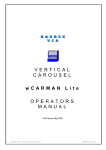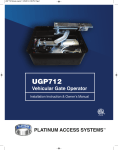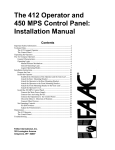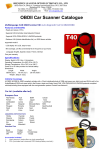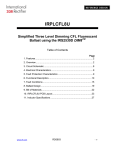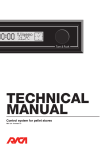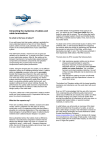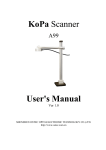Download User Manual 500 & 700
Transcript
User Manual 500 & 700 Polaris 700/702 Polaris 500/502 Document revision: 1.1 Page 1 Warning: Before installing your Polaris Automatic Gate operator (sometimes also referred to as the “Product”), read this entire Installation Manual for information about Product safety matters and proper use of the Product. Only use the Product for the purpose of operating a driveway gate. Table of Contents Gate Operator Class Categories .............................................................................. 4 Warnings and Precautions ........................................................................................ 5 Installing The Polaris Operator(s)............................................................................. 8 Pull-to-Open Gate Operator Mounting ..................................................................... 9 Push-to-Open Gate Operator Mounting ................................................................. 11 Post Mount Brackets ............................................................................................... 13 Circuit Board Diagram ............................................................................................. 16 Board Layout Description ....................................................................................... 16 Dip Switches ............................................................................................................. 17 Wiring Operator ........................................................................................................ 18 Pull-to-Open Limit Setting ....................................................................................... 22 Push-to-Open Limit Setting ..................................................................................... 24 Primary/Secondary Gate Movement ....................................................................... 26 Obstruction Sensitivity Set Up ............................................................................... 27 Auto Close Timer ..................................................................................................... 28 Transmitter/Receiver ............................................................................................... 29 Accessory Hook Up Diagram .................................................................................. 30 Exit Wand Hook Up Diagram ................................................................................... 33 Photo Eyes Hook Up Diagram ................................................................................ 34 Emergency Disconnect ........................................................................................... 36 Technical Specifications ......................................................................................... 37 Parts List and Illustrations ...................................................................................... 38 Troubleshooting/Maintenance ................................................................................ 40 List of Accessories .................................................................................................. 42 Page Polaris Automatic Gate Operators 8617 Paseo Alameda NE Albuquerque, NM 87113 Phone: 877-313-8902 Fax: 800-830-3952 Email: [email protected] Web: www.polarisgate.com 2 Warranty ................................................................................................................... 43 WARNING OF RISKS, PURCHASER’S RESPONSIBILITIES, AND ASSUMPTION OF CERTAIN RISKS: The directions for installation and use of the Product must be followed carefully. It is impossible to eliminate all risks inherently associated with use of the Product. The effectiveness of the Polaris Automatic Gate Operator depends on proper installation and the manner of use or application, all of which are beyond the control of Polaris Professional Products or the seller. All such risks are assumed by the purchaser, and by the purchaser’s installation and use of the Product. Page 3 The Polaris Automatic Gate Operator is for use on driveway gates only. The Product meets or exceeds the requirements of UL 325, the standard that regulates gate operator safety, as established and made effective March 14, 2003, by Underwriters Laboratories, Inc. Gate Operator Class Categories Gate operator CLASS CATEGORIES* The Polaris Automatic Gate Operator is intended for use with vehicular swing gates. The operator can be used in Class I and Class II applications. Residential Vehicular Gate Opener–Class I: A vehicular gate opener (or system) intended for use in a home of one-to-four single family dwelling, or a garage or parking area associated therewith. Light Commercial/General Access Vehicular Gate Opener Class II: A vehicular gate opener (or system) intended for use in a commercial location or building such as a multifamily housing unit (five or less single family units), hotel, garages, retail store or other building servicing the general public. Industrial/Limited Access Vehicular Gate Opener–Class III: A vehicular gate opener (or system) intended for use in an industrial location or building such as a factory or loading dock area or other locations not intended to service the general public. Restricted Access Vehicular Gate Opener–Class IV: A vehicular gate opener (or system) intended for use in a guarded industrial location or building such as an airport security area or other restricted access locations not servicing the general public, in which unauthorized access is prevented via supervision by security personnel. *Categories established by Underwriters Laboratories for vehicle gate operators Polaris is a high end residential gate operator. Also suited for light commercial applications. Not advised for continuous duty. 4 Retailer/store name: __________________ Customer Service 8:00am to 5:00pm, MST, Monday – Friday Polaris Gate Operators 8617 Paseo Alameda NE Albuquerque, NM 87113 Phone: 877-313-8902 Fax: 800-830-3952 Email: [email protected] Page GATE OPERATOR CLASS CATEGORIES FOR YOUR RECORDS Please record the serial number (found on the control box cover) and purchase information below. Keep this with your proof of purchase (receipts) in case your product is lost, stolen or requires service. Serial number: _______________________ Purchase date: ____________________ Warnings and Precautions The gate operator’s built-in means of entrapment protection (Type A) may not be sensitive enough to prevent bodily injury in some circumstances. Secondary means of entrapment protection (Type B1), such as a photo cell are suggested for enhanced safety. WARNING – To reduce the risk of injury or death: • SAVE THESE INSTRUCTIONS • Use this operator only with swing gates. • READ AND FOLLOW ALL INSTRUCTIONS. • Never let children operate or play with gate controls. • Keep the remote control away from children. • Always keep people and objects away from the gate. • NO ONE SHOULD CROSS THE PATH OF THE MOVING GATE. • The entrance is for vehicles only. Pedestrians must use a separate entrance. • Remember that the Polaris Automatic Gate Operator must only be installed on gate systems meeting the requirements of the application. • Ensure that you are using the correct gate operator for the type and size of gate, its frequency of use and the class rating. • • • • • • • • Ensure that the gate and gate operator installation comply with applicable local codes. Contact local fire and law enforcement to arrange emergency access procedures. Keep people, animals, and property away from the gate area. Do not let children play in or near the gate area. Use caution with moving parts to avoid injuring fingers or hands. Consider installing contact sensors, or non-contact sensors to provide additional safety and protection against entrapment. Never activate the gate operator until you ensure that the area is clear of people, pets, or other obstructions. Watch the gate until it stops. Controls must be far enough from the gate so that the user is prevented from coming in contact with the gate while operating the controls. 5 The Polaris Automatic Gate Operator is designed to provide for safe operation. One of the most important safety features of the gate operator is obstruction sensing. When there is an obstruction that prevents the gate from opening or closing, the gate will immediately reverse direction and return to the fully open or closed position. While in the process of returning to the fully open or closed position, if the gate senses an additional obstruction the gate will stop immediately and sound an alarm. At this point the gate operator will need to be reset by turning the power switch on the control box OFF for a minimum of ten seconds. The Polaris gate operator includes an adjustment for setting the sensitivity of the obstruction performance. Refer to page 27 for Obstruction Sensitivity Set Up details. Vehicular gates are large heavy objects. Polaris Automatic gate operators provide a convenient way to open and close the gates. Since the gate system and its components exert a high level of force to open and close the gate, they can be dangerous, causing severe injuries or death to you and others. Your safety and the safety of others depend on the installer of this system to read, understand, and follow the information and instructions in this manual. The Polaris Automatic Gate Operator is designed to comply with UL 325, the safety standard covering automatic gate opening systems. UL 325 requires that gate opening systems have provisions for, or be supplied with, at least one independent primary and one independent secondary means of protection against entrapment. The primary means of entrapment protection in the Polaris Automatic Gate Operator is Type A, an inherent means of entrapment protection. The secondary means of entrapment protection in the Polaris Automatic Gate Operator is Type B1, the provision for the connection of a photo cell or other non contact sensor Safety overview checklist: Page General Safety Information Protection against Entrapment Important! Study the figure below and keep safety foremost at all times. Entrapment areas for a proper pull-to-open installation Entrapment Area 1 Hinged edge of the gate and the fence post Entrapment Area 2 Between the gate and the gate post Entrapment Area 3 The path of the gate Entrapment Area 4 The space between the gate in the open position and any object such as a wall, fence, tree, etc. Entrapment Area 5 Pinch points between the operator and gate or post Area 1 Area 2 Area 5 Area 3 Area 4 Page 6 Driveway Gate in open position Entrapment Alarm Warning Signs and Labels (UL 325; 30.1) In compliance with UL 325 the Polaris Automatic Gate Operator is designed to stop and reverse direction within two seconds of sensing an obstruction. In addition, the Polaris Automatic Gate Operator activates an audible alarm if the unit incurs an obstruction twice while opening or closing. This alarm sounds for five minutes, or until the operator receives a renewed, intended input from a hardwired control such as the Push Button Control. At that point the gate returns to a fully open or fully closed position. Turning the power switch on the control box OFF for ten seconds and back ON also deactivates the alarm. Required Safety Precautions for Gates Warning signs alert people of automatic gate operation. They are required when installing the Polaris Automatic Gate Operator. If pedestrians will be in the area, install a walkthrough gate for their use. Warning Signs The warning signs must be installed on both sides of the gate. These warning signs and decals must be used. If any were missing when the gate operator was purchased, immediately contact Polaris Automatic Gate Operators for replacements. Figure 2 Warning signs (two enclosed) to be installed on each side of the gate (three to five feet above the bottom of the gate) Figure 3 Page 7 Install warning decals, one on each side of gate operator INSTALLING THE POLARIS 500 & 700 SWING OPERATOR WARNINGS--------------------1. Read and follow all instructions. 2. NEVER let children operate the gate or play with the controls. 3. Keep people and objects away from the gate and its immediate areas, both open and closed. 4. After the limit adjustments are made, all auto reversing controls including the current sensing circuit built into the Polaris must be checked. They must be working and set to proper sensitivity. Failure to adjust and retest the gate system increases the chance of injury or death. 5. Test the system MONTHLY. Check to make sure that all auto-reversing devices including the current sensing circuit are working and set to the proper sensitivity. 6.Verify that the emergency (manual) release pin connected to the gate leaf can be easily removed. This check should only be made with the battery disconnected to prevent the gate from moving during the test. 7. This is a VEHILCLE GATE ONLY. Pedestrians must use a separate entrance. 8. NEVER install any control device on the outside of the Polaris cabinet or in such a way that someone can reach through the gate to activate it. 9. SAVE THESE INSTRUCTIONS! CAUTIONS----------------------1. NEVER operate the gate unless you can see it. 2. Do not enter the gate area while the gate is in motion. 3. Do not allow children near the gate and do not allow anyone to ride on the gate. 4. Do not attempt to drive through the gate opening while the gate is in motion. Page 8 ENTRAPMENT ZONES--------------------Zone 1- Leading edge of the gate and catch-post Zone 2- Area between gate and hinge post. Zone 3- The gate path or "arc of the swing" Zone 4- The area between the gate in its' open position and any obstruction like a fence, building, landscaping feature, etc... Zone 5- Not shown below but similar to zone 1- the point where two biparting gate leafs meet when closed. 9 Page 10 Page 11 Page Bushings to be set between bottom side of actuator rod ends and mounting bracket 12 Page Amazing Gates Post Mount Brackets Pull and Push Arm with Amazing Gates 3 1/2" Posts With the purchase of a Polaris Opener System, you will receive the Amazing Gates Universal Pull brackets and gate attach bracket(s). The Amazing Gates post attachment arm does not require drilling of the post to be installed. You simply set it into the position and bolt it tight. The correct angle is preset. 13 3 1/2" Post Push to Open Page 3 1/2" Post Pull to Open Amazing Gates Post Mount Brackets Pull and Push Arm with Amazing Gates 5" Posts With the purchase of a Polaris Opener System, you will receive the Amazing Gates Universal Pull brackets and gate attach bracket(s). The Amazing Gates post attachment arm does not require drilling of the post to be installed. You simply set it into the position and bolt it tight. The correct angle is preset. 14 5" Post Push to Open Page 5" Post Pull to Open Amazing Gates Post Mount Brackets Pull/Push Arm with customers existing Posts other than Amazing Gates. Page 15 With the purchase of a Polaris Opener System, you will receive the Amazing Gates Universal Pull and Push brackets and gate attach bracket(s). These brackets can be used with your exiting posts or any non-Amazing Gates posts, to include column mounting. Though the Amazing Gates bracket system can be used on any post/column setup, the diagram shown below must be followed concerning geometry of pivot point and hinge point. Board Layout Description 16 Buttons 16. Cycle – used as an input device 17. Set Limit 18. Learn Code 19. Power Save Fuses 20. 15 amp Fuse 21. 4 amp Fuse Connectors 22. Buzzer Connection 23. RF Board Connection Page LED’s 1. 18 VAC Power 2. 24V Converter 3. Gate Operator Retracting 4. Gate Operator Extending 5. Obstruction 6. Auto Close 7. Battery OK 8. Battery Charging 9. Status 10. Safety Loop 11. Shadow Loop 12. Exit Loop 13. Radio Receiver Potentiometers 14. Stall Force Adjustment 15. Auto Close Adjustments DIP SWITCHES * - Default factory setting Block 1, DIP Switch 1 – Auto Close ON – Auto close feature enabled OFF* – Auto close feature disable Block 2, DIP Switch 2 – Pull-to-Open or Push-toOpen for Primary Gate Operator ON – Primary gate operator set up for push-to-open operation OFF* – Primary gate operator set up for pull-to-open operation Block 1 Block 2 NOTE: All DIP Switches are shown in the factory Block 2, DIP Switch 3 – Pull-to-Open or Push-toOpen for Secondary Gate Operator ON – Secondary gate operator set up for push-toopen operation OFF* – Secondary gate operator set up for pull-toopen operation NOTE: Only active if Block 2, DIP Switch 1 is set in the ON position Block 2, DIP Switch 1 – Single or Dual Gate ON – Dual gate applications OFF* – Single gate applications Block 1, DIP Switch 2 – Audible Motion Alarm ON – Audible motion alarm enabled OFF* – Audible motion alarm disabled Block 1, DIP Switch 3 – Extended Soft Start/Stop NOTE: To adjust auto close time refer to figure 17. 17 Block 1, DIP Switch 4 – Time of Soft Start/Stop ON – Max. extended time of soft start/stop operation OFF* – Extended time of soft start/stop operation NOTE: Only active if Block 1, DIP 3 is set to ON Block 2, DIP Switch 5 – Sequencing of Dual Gate Opening and Closing ON – Secondary gate operator opens first and closes second (2 second delay) OFF* – Primary gate operator opens first and closes second (2 second delay) NOTE: Only active if Block 2, DIP 4 is in the ON position Block 2, DIP Switch 6 – Dual Gate Position Limit Settings ON – Set limit setting for secondary gate operator OFF* – Set limit setting for primary gate operator NOTE: Only active if Block 2, DIP Switch 1 is set in the ON position Block 2, DIP Switch 7 – Off - Not Used Block 2, DIP Switch 8 – Off - Not Used Page Block 2, DIP Switch 4 – Timing of Dual Gates ON – One gate is delayed when opening or closing OFF* – Gates open and close simultaneously NOTE: Only active if Block 2, DIP Switch 1 is set in the ON position ON – Extended soft start/stop operation enabled OFF* – Normal soft start/stop operation WIRING OPERATOR NOTE: Before powering, gate operator must be connected to the control box – damage may occur if gate operator is connected directly to a battery or other power source. Step 1 Ensure the control box power switch is in the OFF position. The control box power switch is located on the bottom of the control box. NOTE: Use only 16 gauge dual conductor, multistranded, direct burial wire for AC power hookup. Follow local electrical codes. Step 2 If using AC power to charge the battery, connect wire to the control box as shown in fig. 19. If charging battery with a solar panel(s), refer to Accessory Hook-Up Diagram fig. 32 on page 28. Connect wires from primary operator (and secondary operator if installing on a dual gate) to the control box as shown in fig. 19. Wire should be buried in accordance with local codes. WARNING: DO NOT CONNECT BOTH TRANSFORMER AND SOLAR PANEL. THIS SYSTEM IS DESIGNED TO RUN ON ONLY ONE POWER SOURCE. CONNECTING BOTH POWER SOURCES CAN RESULT IN DAMAGE TO CIRCUIT BOARD AND WILL VOID WARRANTY. Page 18 Figure 19 Circuit Board Step 3 The transformer provided is for dry location use only. If used in an outside outlet, the transformer must be enclosed or covered for weather protection. Attach AC power wire to the transformer. NOTE: DO NOT PLUG TRANSFORMER INTO AC POWER UNTIL ALL WIRING IS COMPLETED. Step 4 Install the battery by placing the battery into the control box. The control box can accommodate one or two batteries. Batte Second Battery (not included) Warning: Do not attempt to splice operator wires for the purpose of extending your wiring connections. Doing so can void your warranty. Contact technical support for recommended procedure. 1-877-313-8902. Figure 22 Step 5 Connect the battery terminal wires to the battery. Step 6 Plug in transformer. Turn control box power switch to the ON position. Red (+) terminal Page WARNING: Please make sure the batteries are fully charged before connecting and powering up the new circuit board. Undercharged batteries may damage the circuit board and void your warranty. 19 Black (-) Polaris Automatic Gate Operators come equipped with a Power Save feature. The default mode is for all LED’s to be operational as described. If it is desired to conserve power to maximize battery life Recommended for the following steps can be taken. Press and hold the PWR SAVE button for three seconds. An audible beep will sound confirming the change to the power save mode. This will disable several LED’s when not activated for five minutes. In Power Save mode, the LED’s will operate as described upon an input. When the gate sits idle for five minutes, the LED’s will turn off to conserve power. When troubleshooting the installation it is recommended to disable the Power Save feature. The feature can be disabled by pressing and holding the PWR SAVE button for three seconds. Two audible beeps will sound confirming the change to normal mode operation. 20 LED Descriptions Proper wiring and performance can be verified by checking the operation of the LED’s located on the circuit board. LED #1: 18VAC OK Lit when AC power is being supplied to the circuit board. LED #2: +24V OK Lit when 24V converter is activated. LED #3: IN There are two “IN” LED’s. One near the Opener 1 terminals and one near the Opener 2 terminals. One LED will light when a single gate operator is retracting. Both LED’s will light when dual gate operators are retracting. LED #4: OUT There are two “OUT” LED’s. One near the Opener 1 terminals and one near the Opener 2 terminals. One LED will light when a single gate operator is extending. Both LED’s will light when dual gate operators are extending. LED #5: OBSTR Lit when an obstruction is sensed. LED #6: TIMER ON Blinks when auto close feature is enabled and gate is in open position. Lit when gate arm cycle limiter is automatically activated. LED #7: BATT OK Lit when battery is OK or “charged.” LED #8: CHARGING Lit when battery is being charged. LED #9: STATUS Blinks to indicate that the system is functioning properly. Also used to indicate a user input during installation. LED #10: SAFETY LOOP Lit when the safety loop contact is made. LED #11: SHADOW LOOP Lit when shadow loop contact is made. LED #12: EXIT LOOP Lit when an exit loop contact is made. LED #13: RADIO RECVR Lit while transmitter button is pushed. Power Save Mode (Recommended for Solar Applications) Page WIRING THE OPERATOR Page 21 WIRING THE OPERATOR PULL-TO-OPEN LIMIT SETTING (Open gate to inside of property) Single Gate Installations Step 1 Make sure the gate is in the fully open position. Ensure power switch is in the ON position. Step 2 Verify Block 2, DIP Switch #1 is in OFF position. Press the cycle button on circuit board and the gate will begin to close. Stop the gate using the cycle button when the desired limit has been reached. Step 3 Press and hold the “SET LIMIT” button until one audible beep is heard to acquire the closed limit setting. The STATUS light will turn on immediately upon pressing the SET LIMIT button. The STATUS light will turn off and an audible beep will verify the closed limit is now set. Step 4 Press cycle button on circuit board to return the gate to the fully open position. ***Dip switch number 6 dictates which gate is being affected by the set limit button, whether setting or clearing the limit. If dip switch 6 is in the up position, it will set or clear the limit for the secondary operator. If it’s in the down position it will set or clear the limit for the primary operator.*** 22 Step 6 CLEARING THE CLOSED LIMIT SETTING: a) Return the gate to the fully open position. b) Press and hold the SET LIMIT button until two audible beeps are heard. c) Two audible beeps will verify the closed limit setting is now cleared. Repeat steps 1 – 5 to program the gates “closed limit setting”. WARNING: Do not use hand held transmitters to program primary and secondary limits. Only the cycle button should be used until final set up is complete to avoid damage to actuators and voiding warranty. Page Step 5 Again, using the cycle button close the gate to verify it meets the desired location. If the gate did NOT reach the desired closed limit, proceed to step 6. 23 Step 8 CLEARING THE CLOSED LIMIT SETTINGS: a) Return the gates to the fully open position. b) Set Block 2, DIP switch #6 to the OFF position. c) Press and hold the SET LIMIT button until two audible beeps are heard. Two audible beeps will verify the closed limit setting is now cleared. d) Set Block 2, DIP switch #6 to the ON position. e) Press and hold the SET LIMIT button until two audible beeps are heard. Two audible beeps will verify the closed limit setting is now cleared. Repeat steps 1 – 7 to program the gates “closed limit setting”. Page PULL-TO-OPEN LIMIT SETTING Dual Gate Installations Step 1 Make sure both gates are in the fully open position. Ensure power switch is in the ON position. Step 2 Verify Block 2, DIP Switch #1 is in ON position. Press the cycle button on the circuit board and the gates will begin to close. Stop the gates using the cycle button when the desired limit for the primary gate has been reached. Step 3 Verify Block 2, DIP Switch #6 is in the OFF position. Press and hold the “SET LIMIT” button until one audible beep is heard to acquire the closed limit setting(fig. 28).The STATUS light will turn on immediately upon pressing the SET LIMIT button. The STATUS light will turn off and an audible beep will verify the closed limit is now set. Step 4 Press the cycle button on circuit board to return the gates to the fully open position. Step 5 (setting secondary gate) Set Block 2, DIP switch #6 to the ON position. Again, press the cycle button. The gates will begin to close. The primary gate should stop at the closed limit position that was programmed in the previous steps. The secondary gate will continue to close until you press the cycle button on the circuit board. Step 6 Press and hold the “SET LIMIT” button until one audible beep is heard to acquire the closed limit setting (fig. 28). The STATUS light will turn on immediately upon pressing the SET LIMIT button. The STATUS light will turn off and an audible beep will verify the closed limit is now set. Step 7 Press the cycle button on circuit board to open both gates. Then once again press the button to close the gates and verify the closed limits are set properly. If the gates did not reach the desired closed limits, proceed to Step 8. PUSH-TO-OPEN LIMIT SETTING (Open Gate to Outside) Single Gate Installations Step 1 Make sure the gate is in the fully closed position. Ensure power switch is in the ON position. Step 2 Verify Block 2, DIP Switch #1 is in OFF position and Block 2, DIP switch 2 is in the ON position. Press the cycle button on circuit board and the gate will begin to open. Stop the gate using the cycle button when the desired limit has been reached. Step 3 Press and hold the “SET LIMIT” button until one audible beep is heard to acquire the open limit setting. The STATUS light will turn on immediately upon pressing the SET LIMIT button. The STATUS light will turn off and an audible beep will verify the open limit is now set. Step 4 Press cycle button on circuit board to return the gate to the fully closed position. ***Dip switch number 6 dictates which gate is being affected by the set limit button, whether setting or clearing the limit. If dip switch 6 is in the up position, it will set or clear the limit for the secondary operator. If it’s in the down position it will set or clear the limit for the primary operator.*** 24 Step 6 CLEARING THE OPEN LIMIT SETTING: a) Return the gate to the fully closed position. b) Press and hold the SET LIMIT button until two audible beeps are heard. c) Two audible beeps will verify the open limit setting is now cleared. Repeat steps 1 – 5 to program the gates “open limit setting”. WARNING: Do not use hand held transmitters to program primary and secondary limits. Only the cycle button should be used until final set up is complete to avoid damage to actuators and voiding warranty. Page Step 5 Again, using the cycle button open the gate to verify it meets the desired location. If the gate did NOT reach the desired open limit, proceed to step 6. c) Press and hold the SET LIMIT button until two audible beeps are heard. Two audible beeps will verify the open limit setting is now cleared. d) Set Block 2, DIP switch #6 to the ON position. e) Press and hold the SET LIMIT button for until two audible beeps are heard. Two audible beeps will verify the open limit setting is now cleared. Repeat steps 1 – 7 to program the gates “open limit setting”. 25 Step 1 Make sure both gates are in the fully closed position. Verify Block 2, DIP Switch #1,2 & 3 are in the ON position, Step 2 Ensure power switch is in the ON position. Press the cycle button on the circuit board and the gates will begin to open. Stop the gates using the cycle button when the desired limit for the primary gate has been reached. Step 3 Press and hold the “SET LIMIT” button until you hear one beep to acquire the open limit setting (fig. 29). The STATUS light will turn on immediately upon pressing the SET LIMIT button. The STATUS light will turn off and an audible beep will verify the open limit is now set. Step 4 Press cycle button on circuit board to return the gates to the fully closed position. Step 5 Again, press the cycle button on circuit board. The gates will begin to open. The primary gate should stop at the open limit position that was programmed in the previous steps. The secondary gate will continue to open until you press the cycle button. Step 6 (setting secondary gate) Set Block 2, DIP switch #6 to the ON position. Press and hold the “SET LIMIT” button until you hear one beep to acquire the open limit setting (fig. 29). The STATUS light will turn on immediately upon pressing the SET LIMIT button. The STATUS light will turn off and an audible beep will verify the open limit is now set. Step 7 Press the cycle button on circuit board to close both gates. Then once again press the button to open the gates and verify the open limits are set properly. If the gates did not reach the desired open limits, proceed to step 8. Step 8 CLEARING THE OPEN LIMIT SETTINGS: a) Return the gates to the fully closed position. b) Set Block 2, DIP switch #6 to the OFF position. Fig.29 Page Dual Gate Installations PRIMARY/SECONDARY GATE MOVEMENT For dual gate installations the timing of the gates opening and closing can be adjusted. To set a dual gate installation for both gates to open and close simultaneously, set the DIP switches as follows. Block 2, DIP 1 – ON position Block 2, DIP 4 – OFF position If it is desired to have one gate open and close prior to the other, this can be accomplished by adjusting the DIP switch settings. Block 2, DIP 1 – ON position Block 2, DIP 4 – ON position Now determine which gate is desired to open first and close second. Another DIP switch adjustment is required to set this. For primary gate operator (wired to operator 1 terminals) to open first and close second: Block 2, DIP 5 – OFF position For secondary gate operator (wired to operator 2 terminals) to open first and close second: Block 2, DIP 5 – ON position The delay in opening and closing is always set for two seconds. PRIMARY/SECONDARY GATE MOVEMENT Page 26 Control Box Cover Once you have programmed your remote/keypad, you can then install the cover of the control box. Use five #10 x 3/4” screws to secure the cover to the control box. OBSTRUCTION SENSITIVITY SET UP Figure 31 * Note: Cycle is an open/close input. Exit is a open only input. IMPORTANT: For safety reasons the obstruction setting or stall force on the Polaris Automatic Gate Operator control board comes from the factory set at minimum, (turned all the way counter-clockwise). In many gate installations, this setting will need to be adjusted to overcome the weight and size of the gates. The STALL FORCE potentiometer on the circuit board controls the obstruction sensitivity (or the amount of force the operator will apply to an obstruction) before it automatically stops and reverses direction of the gate. Adjust the sensitivity beginning at the factory default counter-clockwise position. Continue to incrementally increase the force until the gate can open and close without obstructing under its own weight. Obstruction Potentiometer NOTE: The stall force may need to be increased in cold weather due to increased resistance from gate hinges. NOTE: The OBSTR LED will light to indicate an obstruction is sensed. Page 27 NOTE: The Stall Force dial in Figure 31 should ideally be at the 10 o’ clock position instead of the 12 o’ clock position pictured. Auto Close Timer The amount of time between opening the gate and automatically closing the gate can be adjusted between 0 seconds and 120 seconds. The adjustment is made by turning the CLOSE TIMER potentiometer. The default position of the potentiometer is zero seconds. Timer will activate after gates have completed one full cycle. To increase the delay time, turn the potentiometer clockwise. POLARIS STRONGLY RECOMMENDS THE USE OF A SAFETY DEVICE SUCH AS: PHOTO BEAMS OR SAFETY LOOP WHEN AUTO CLOSE TIMER IS ACTIVATED! Page 28 NOTE: Only active if Block 1, DIP switch 1 is in the ON position. DIP Switches Transmitter Figure 26 29 NOTE: All Polaris Automatic Gate Operator transmitters use a standard code set at the factory. It is recommended that this code is re-set for safety and security before programming receiver. Step 1 Remove the battery access cover on the transmitter. When the cover is off, you will see the battery and the DIP switches. Step 2 The DIP switch block contains 10 small switches. Using a small screwdriver or pen, move any switch or combination of the switches to either the open or closed position. NOTE: Do not set the switches to all open or all closed. Step 3 Locate the LEARN CODE button on the circuit board in the control box. Step 4 Press and hold the LEARN CODE button for at least three seconds, but no more than five seconds. Upon release, the CHARGING LED will light, the STATUS LED will stop blinking, and an audible beep will occur verifying the circuit board is in the learn code mode. Step 5 Press and hold the transmitter button until the CHARGING LED turns off, the STATUS light blinks, and an audible beep occurs. Release the transmitter button. The transmitter code is now set. Step 6 Replace the battery access cover on the transmitter. Step 7 Verify the transmitter is operational by pressing the transmitter button. The RADIO RECEIVER LED will light and the gate will move if the setting is correct. If the gate does not move, repeat the process starting with step 4. NOTE: The control box circuit board can learn and hold up to 10 different codes. NOTE: To clear all codes, press and hold the LEARN CODE button for 10 seconds. Two audible beeps verify LEARN CODE has been cleared. Figure 25 Page TRANSMITTER/RECEIVER Page 30 * Note: Some accessories may require additional wire and/or hardware and is to be supplied by the installer. ACCESSORY HOOK UP DIAGRAM Telephone Entry System Accessory Connections Strip Fire Access Control Keyswitch Control Magnetic Lock- #2 see page 30 Solenoid Lock- #1 see page 30. Page 31 Please refer to Magnetic Lock instruction manual for connection instructions. Connections differ for 12v or 24v connection. ACCESSORY HOOK UP DIAGRAM Wired Keypad Photo Eye Beams 32 External Radio Receiver Page Victory PB-1200 Photo Eye Beams Page 33 EXIT WAND HOOK UP DIAGRAM PHOTO EYE HOOK UP DIAGRAM NIR Photo Eye The NIR photo-eye has two parts: the EMITTER and the REFLECTOR. The EMITTER has 5 screw terminals labeled by color. Attach the terminals in the emitter to those on the gate operator circuit board as shown below. Use a direct-burial type of control wire like "sprinkler wire" and position the emitter on the hinge-side of the Brown Gray White Black Blue *Black wire not used* Page *Use these instructions in combination with the NIR instructions that come with the photo eyes.* 34 NIR Photo PHOTO EYE HOOK UP DIAGRAM IRB 4X Photo Eye Page *Use these instructions in combination with the IRB 4X instructions that come with the 35 The IRB 4X photo-eye has two parts: the TRANSMITTER and the RECEIVER. The TRANSMITTER has 2 screw terminals labeled plus and minus. The RECEIVER has 5 terminals, DO NOT use terminal #4. To connect the units to the gate operator circuit board, see the drawing below. Use a direct-burial type of control wire like "sprinkler EMERGENCY DISCONNECT Page 36 CAUTION: The gate will move freely and uncontrolled when the gate operator is removed from the gate. ONLY disconnect the gate operator when the control box power switch is OFF and the gate is NOT moving. TECHNICAL SPECIFICATIONS Mechanical Specifications Electrical Specifications Motor: 24 VDC Voltage Ratings: Powered by a 24 v VDC motor 18 VAC transformer: 18.0 to 22.0 VAC 12 V Battery: 12.0 to 13.5 VDC 7.2Ah Charging Circuit: 12.0 to 14.8 VDC Shipping Weight: POLARIS 500: 65 lbs POLARIS 500/502: 88 lbs POLARIS 700: 65 lbs POLARIS 700/702: 90 lbs Transmitter/Receiver Frequency: 433MHz Travel Speed: 16 seconds for 90° (opening under normal conditions and normal load) Transmitter Range: Up to 100 feet (90 meters) *varies greatly depending on gate surroundings 39.6 inches retracted 58.6 inches extended POLARIS 500/502 Capacity Stroke Length Minimum Gate Length 12 feet/200 pounds 19 inches 60 inches 44.6 inches retracted 68.6 inches extended 37 14 feet/300 pounds 24 inches 72 inches Page POLARIS 700/702 Capacity Stroke Length Minimum Gate Length Page 38 PARTS LIST AND ILLUSTRATIONS PARTS LIST AND ILLUSTRATIONS Secondary Gate Operator 40 ft. cable Polaris 502 Polaris 702 Circuit Board Cabinet Dimensions: 14.5h x 12.5w x 6.5d Control Box Transformer Page 39 Battery TROUBLE SHOOTING The gate will not operate using the handheld transmitter. 1. Press transmitter button to verify LED on transmitter illuminates. If not, replace 9V battery. 2. Observe "radio receiver led" on the control board and verify it turns on when transmitter button is pressed. If so,the transmitter is working correctly refer to troubleshooting section “The Gate Will Not Operate.” If the LED does not illuminate, proceed to step 3. 3. Refer to page 22 of manual “Transmitter/Receiver” and relearn the transmitter code. If the problem still exists proceed to step 4. 4. Verify RF Board Connection. If connections are correct, please call technical support. The Gate Will Not Close Automatically 1. Make sure dip switch 1, block 1 is in the on position. 2. Adjust timer to preferred close time. 3. Gate must complete one full cycle before timer is activated. 1. Verify power switch is on. 2. Verify the STATUS LED is blinking approximately once per second. If not, check battery connections and both 4A and 15A fuses. 3. Verify SAFETY LOOP LED, SHADOW LOOP LED and EXIT LOOP LED are not on. If any of these are on, try disconnecting the corresponding device. 4. If using an AC power source, verify the 18VAC LED is on. 5. Verify the 12V battery voltage. If below 12.3V, then replace or recharge the battery. 6. Clear and redefine limits as described earlier in the manual. 7. Try the CYCLE button on the control board. 8. Verify all connections especially the actuators. 9. Verify FIRE BOX, PHOTO BEAMS, or EXIT WAND (if installed) is not preventing gate movement. The gate(s) are operating slowly. 1. This is usually due to low power. Check voltage on batteries. If voltage is below 12.3V, allow time for batteries to charge before operating gates. (if this is a solar application and there has been a lack of sunlight, you will need to charge batteries with a trickle charger before operating your gate(s).) The status light is flashing rapidly. 1. This is also most likely due to a power problem. Check battery voltage and charge batteries if necessary. 2. After batteries are fully charged, power down system for 5 seconds and turn back to on position. There are no remaining inputs for 12vdc for my accessories. 1. You may create a pigtail connection and connect more than one accessory to a 12vdc input connector. Can I adjust the actuator manually to fit my gate? 1. No. The actuator must be installed in the fully retracted position and connected to the gate attach bracket at that point. Please refer to page 10 for a pull-to-open application or page 12 for a push-toopen application. 40 1. Verify the gate frame is not encountering an obstruction and the gate hinges are not binding. 2. If the OBSTR LED is lit, the stall force may be set too sensitive. Increase the stall force by turning the STALL FORCE potentiometer clockwise 1/8 turn. Operate the gate again to see if the problem still exists.If the problem still exists increase the stall force again and retry. If the problem still exists procee to step 3. CAUTION: Increasing the stall force reduces obstruction protection. 3. Reset the operator by turning the power off for five seconds. Turn the power back on and press the CYCLE button and allow the operators to fully retract.Try operating the gate again to see if the problem still exists. If the gate stops before reaching the desired position, clear and redefine the limit settings as described earlier in the manual. 4. Check for any loose or incorrect connections. 5. If steps 1–4 did not solve the problem please call technical support at 1-877-313-8902. The gate(s) will not operate. Page The gate(s) stops or reverses before reaching the desired position. TROUBLE SHOOTING MAINTENANCE The 15 amp fuse is blown. Preventive Maintenance • Using a clean, dry cloth, wipe the gate operator shaft, and then apply a silicone spray. The silicone spray will reduce friction in extreme temperature ranges and help the gate operator operate smoothly. This should be repeated every 4–6 weeks. If needed, spray a small amount of silicone lubricant into tiny pinhole found on shaft of actuator with actuator in extended position. • Check the gate hinges to make sure gate is swinging smoothly and freely. Grease hinges if needed. • Check batteries occasionally for corrosion and clean leads if necessary. Check voltage occasionally. • In some cold weather climates it is recommended to purchase battery heaters to ensure that your batteries maintain a charge throughout cold weather months. In this case, battery heaters need to be unplugged during spring, summer and fall months to prevent overheating. • For optimal performance, it’s recommended that new batteries be installed annually. 1. Check wiring from transformer to circuit board. 2. Check for any loose or incorrect connections. 3. Check battery connections for any corrosion or loose wires. 4. After replacing fuse, verify that 18vac light is illuminated. (this is not valid on a solar powered system.) 5. Call technical support if fuse blows again. How do I reset the limits on my gate(s)? 1. Make sure you start with both arms in the fully retracted position. 2. Clear the limits on both arms by pressing the set limit button and holding it in until it beeps twice. Set dip switch 6 in the opposite position and press set limit again until it beeps twice. You have now cleared the limits for both operators. 3. Dip switch number 6 dictates which gate is being affected by the set limit button, whether setting or clearing the limit. If dip switch 6 is in the up position, it will set or clear the limit for the secondary operator. If it’s in the down position it will set or clear the limit for the primary operator. 4. Once limits have been cleared, cycle the gates to (close- pull to open) or (open- push to open) and stop the gates using the cycle button when a gate gets to the desired closed/open position. Once this occurs set the limit for that gate by pressing the set limit button until it beeps once. (make sure dip switch 6 is set appropriately) Cycle the gates back to the open/ closed position. 5. With the gates in the open/closed position, cycle gates to close/open once again. This time stop the gates when the other gate gets to the desired stop location. Once that is accomplished, set the limit for that gate by setting the dip switch 6 correctly and pressing the set limit button until it beeps once. Customer Service 8:00am to 5:00pm, Mountain Time Monday – Friday Polaris Gate Operators 8617 Paseo Alameda NE Albuquerque, NM 87113 Phone: 877-313-8902 Fax: 800-830-3952 email: [email protected] 41 The 4 amp fuse is blown. Page 1. Check wiring from actuator arms to circuit board for loose or cut connections. 2. Verify that all wiring is correct according to page 18. 3. Check for any overheating or singed wiring. 4. Call technical support at 1-877-313-8902 before attempting to replace fuse so as to prevent any further damage. LIST OF ACCESSORIES Solar Powered Battery Charger (20-Watt: RSP20) The solar panel charges the 12 volt battery when AC power is not available. One-Button Transmitter. The transmitter works as an input device allowing the user to open or close the gate from a remote location. It has a range up to 100 feet. Two-Button Transmitter. The two-button transmitter provides the capability to remotely operate two separate devices such as two gates, or a gate and a garage door opener. It has a range up to 100 feet. Mini-transmitter. The mini-transmitter fits on a keychain and allows the user to open or close the gate from a remote location. It has a range up to 100 feet. Keypad. The keypad allows for entry by authorized guests informed of the pre-set code. Entering the correct code causes the gate to open or close. The access code can be easily modified. Pin Lock. The pin lock replaces the clevis pin when mounting the gate operator to the brackets. It helps to prevent theft of the gate operator from the gate, while allowing quick release of the operator. In-Ground Vehicle Sensor. The vehicle sensor is buried near the gate and senses a vehicle that passes within its 12-foot range. Once detected, the gate opens automatically. Page Magnetic Gate Lock. The automatic gate lock provides an additional level of security for the property. When the gate swings shut, the gate lock closes, securing the gate in the closed position. The gate lock is powered from an external AC power source. The locking mechanism is magnetic. 42 Solenoid Gate Lock. The automatic gate lock provides an additional level of security for the property. When the gate swings shut, the gate lock closes, securing the gate in the closed position. The gate lock is powered from the control box of the gate operator. The locking mechanism is a mechanical latch. Two Year Limited Warranty Limited Warranty Coverage If your Polaris Gate Operator (sometimes also referred to as the “Product”) does not work properly because of a defect in materials or workmanship, Polaris Gate Operators will, for the length of the period indicated below, which starts with the date of the original purchase by the first non-consumer purchaser (the “Limited Warranty period”), at its option either (a) repair your Product with new or refurbished parts, or (b) replace it with a new or a refurbished Product. The decision to repair or replace will be made by Polaris Gate Operators. Parts Labor Two (2) Years Labor Two (2) Years During the “Labor” Limited Warranty period there will be no charge for labor. (Note: labor applies only to the repair of the Product at an Authorized Repair Center. It does not apply to removal or installation of the Product any purchaser’s premises). During the “Parts” Limited Warranty period, there will be no charge for parts. You must ship your Polaris Gate Operator to Polaris Gate Operators during the applicable Limited Warranty period. This Limited Warranty excludes both parts and labor for batteries, antennas, and cosmetic parts (such as the Product housing). This Limited Warranty only applies to Products purchased in the United States. This Limited Warranty is extended only to the original non-consumer purchaser (“you” or “your”) of a new Product that was not sold “as is”. Limited Warranty Service For assistance in the continental U.S.A. in obtaining the benefit of the Limited Warranty please carefully follow these steps: 1) Complete carefully all troubleshooting procedures in the Maintenance and Troubleshooting Guide in this Manual. 2) If you are still unable to solve the problem, contact Polaris Gate technical support at [email protected]. Please have the model and serial number of the Product available to give to the customer service representative. The customer service representative will provide further assistance or authorize repair or replacement, as appropriate. 3) If repair or replacement is appropriate you will be given a return authorization number (RMA#). This RMA# must be visible on all documents and packages returned to Polaris Gate Operators. 4) Carefully pack the defective Product or Product part in a sturdy shipping carton, include (i) a letter detailing the complaint, (ii) a daytime phone number where you can be reached, (iii) your name and address for any return, (iv) your sales receipt/proof of purchase, and (v) the RMA# on all correspondence and the shipping carton. 43 You may obtain additional copies of this manual from our web site at www.polarisgate.com, or contact Polaris Gate Operators at: 8617 Paseo Alameda NE Albuquerque NM 87113, 877-313-8902. Page WARRANTY 5) Prepay the freight and insure the defective Product or Product part against shipping damage. Note that defective Products or Product parts shipped freight collect will not be accepted. 6) Ship the carton to: Polaris Gate Operators, 8617 Paseo Alameda NE, Albuquerque, NM 87113. IF REPAIR OR REPLACEMENT IS NEEDED DURING THE LIMITED WARRANTY PERIOD, YOU WILL BE REQUIRED TO FURNISH A SALES RECEIPT/PROOF OF PURCHASE INDICATING DATE OF PURCHASE, AMOUNT PAID AND PLACE OF PURCHASE. YOU WILL BE CHARGED FOR THE REPAIR OF ANY PRODUCT OR PRODUCT PART RECEIVED WITHOUT SUCH PROOF OF PURCHASE OR FOR REPAIRS REQUESTED AFTER THE APPLICABLE LIMITED WARRANTY PERIOD. Limited Warranty Limitations and Exclusions This Limited Warranty ONLY COVERS failures due to defects in materials or workmanship, and DOES NOT COVER normal wear and tear or cosmetic damage. The Limited Warranty ALSO DOES NOT COVER damages which occurred in shipment, or failures which are caused by products not supplied by Polaris Gate Operators, or failures which result from accidents, misuse, abuse, neglect, mishandling, misapplication, modifications or alterations, faulty installation, connection to an improper power source, set-up adjustments, mis-adjustment of controls, improper maintenance, power line surges, damage from acts of God such as lightning, wind, fire, flood or insects, introduction of sand, humidity or liquids, commercial or rental use or service by anyone other than an Authorized Repair Center. THERE ARE NO EXPRESS WARRANTIES EXCEPT AS STATED UNDER “LIMITED WARRANTY COVERAGE”. POLARIS GATE OPERATORS IS NOT LIABLE FOR INCIDENTAL OR CONSEQUENTIAL DAMAGES RESULTING FROM THE USE OF THE PRODUCT, OR ARISING OUT OF ANY BREACH OF THIS LIMITED WARRANTY. (As examples, this excludes damages for lost time, lost calls or messages, cost of having someone remove or re-install an installed Product or Product part, travel to and from an Authorized Repair Center, etc. The examples listed are not an exhaustive or exclusive list, but are for illustration only). ALL EXPRESS AND IMPLIED WARRANTIES, INCLUDING ANY IMPLIED WARRANTIES OF MERCHANTABILITY OR FITNESS FOR A PARTICULAR PURPOSE, ARE LIMITED TO THE PERIOD OF THE LIMITED WARRANTY. Some States do not allow the exclusion or limitation of incidental or consequential damages, so the above limitation or exclusion may not apply to you. Some States do not allow limitations on how long an implied warranty lasts, so the above limitation may not apply to you. This warranty gives you specific legal rights, and you may also have other rights which vary from State to State. PARTS AND SERVICES WHICH ARE NOT EXPRESSLY COVERED BY THIS LIMITED WARRANTY ARE YOUR RESPONSIBILITY.















































